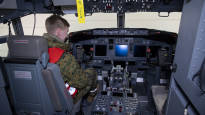Russia’s submarine fleet is a threat to cargo traffic and underwater critical infrastructure. Missiles equipped with nuclear warheads can also be launched from submarines.
Norway is heavily equipped to deal with the threat posed by Russian submarines. It is possible for Russian submarines to launch nuclear missiles thousands of kilometers away and cause minor damage to critical infrastructure, such as communication cables and oil and gas pipelines.
Norway monitors a sea area of two million square kilometers with five reconnaissance aircraft, the newest of which the country received last summer.
Submarines are also tracked by satellites, ships and our own submarines. The added value brought by the P8 Poseidon surveillance machines is considerable, says the Evenes base commander Hans Martin Steiro. They are only used in a few countries, such as the United States and Great Britain.
– Russian submarines can move very fast and only airplanes can surely keep up with them, says Steiro.
The sea area between Greenland, Iceland and Great Britain has traditionally been considered a critical area for anti-submarine warfare. Both data cables and freight traffic between the US and Europe pass through it, and in a crisis, also the transport of military equipment.
– Controlling submarines and securing connections from the United States to the NATO countries of northern Europe is even more important now that Finland and Sweden are also NATO members, Steiro states.
Heaven is monitored daily
Russia’s underwater movements are also monitored for possible sabotage. According to Norwegian military intelligence, the main target of Russia’s hostile activities is precisely Norway’s underwater infrastructure: telecommunications connections and oil and gas pipelines. Russia has mapped their location for a long time.
The breakage of the fiber optic cable running from Svalbard to mainland Norway exposed Russia’s intentions and capabilities two years ago. Russian ships were circling near the cable and they were later also spotted near the exploded Nord Stream gas pipelines and the broken Balticconnector pipeline between Estonia and Finland.
Sabotages can also happen in the future, the commander states the fact.
– But we monitor as best we can and my goal is that these planes are in the air every day, says Steiro.
Surveillance machines home field Evenes is north of the Arctic Circle near the Lofoten Islands. In addition to the mountains, the base is protected by anti-aircraft systems.
The machine is full of electronics
The Poseidons, which observe subsurface events from the sky, are built on the fuselage of a passenger plane familiar from holiday flights.
– The fuselage is 86 percent the same as that of the Boeing 737, says the squadron member presenting the machines. He does not want his name or image to be published.
In the cargo area, there are electronics and larger than usual fuel tanks, in the bow, on the other hand, an efficient radar and in the stern a self-protection system that warns of missiles.
The crew members joke about the wine bottle rack being sturdier than usual, but in reality the rack stores 15 kg listening buoys. They are dropped into the water near the supposed submarine. The operators sitting in the plane receive data about the submarine’s position and direction transmitted by the buoys.
The planes, which cost a total of about 1.2 billion dollars, have cruise missiles under their wings if necessary, and the plane can also be armed with torpedoes.
– We usually fly without weapons, because it could arouse unnecessary aggression, the member of the squadron who remains anonymous mentions.
Russian submarines can launch missiles thousands of kilometers away, with nuclear warheads that they can use to threaten Europe and North America from the Barents Sea.
This week, the Norwegian Poseidon turned around near the Russian border near the Kola Peninsula, where the submarines of the Russian Northern Fleet with their nuclear weapons are located.
Glances at the Flight Radar website at random times tell you that Steiro’s wish seems to be coming true. The P-8 Poseidon of the Norwegian Defense Forces is often in the air somewhere towards northern Norway or the Barents Sea. However, the plane may suddenly disappear from the map, probably after turning off the transponders.
